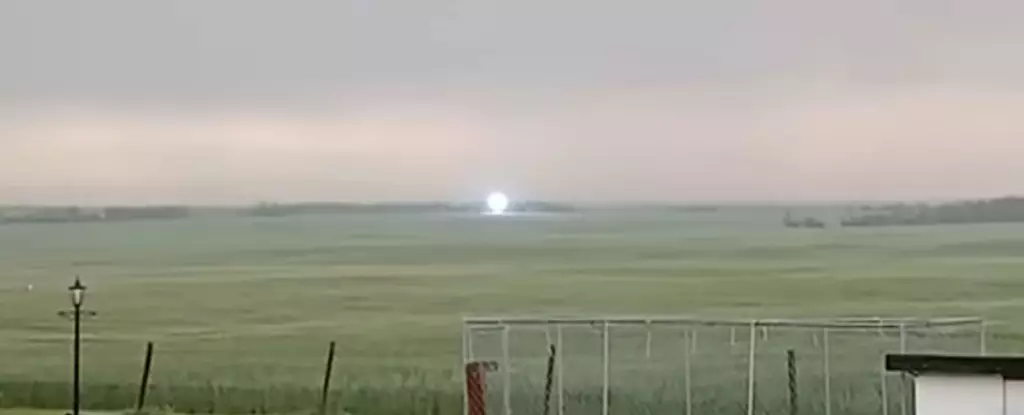In an era where technology continually expands the boundaries of human understanding, moments like the Pardy couple’s recent encounter offer a rare window into phenomena that remain stubbornly shrouded in mystery. What should have been a typical lightning storm suddenly transformed into an extraordinary visual event — a glowing blue orb hovering eerily above the ground. Such an incident challenges not just our scientific comprehension but also tests the limits of human curiosity and skepticism. Is this phenomenon a misunderstood natural event, or are we witnessing something beyond current scientific capability?
The captured footage reveals a strikingly vivid sphere, measuring about one to two meters in diameter, that persists for roughly a minute before abruptly vanishing with a ‘pop’. The vivid blue hue and motionless hovering position evoke a spectacle that straddles the line between scientific possibility and supernatural suspicion. Without concrete scientific validation, the scene becomes an intriguing puzzle for meteorologists and skeptics alike. One cannot help but question: Are we witnessing a rare, authentic atmospheric phenomenon, or is this an anomalous optical illusion, a product of camera artifacts, or perhaps something more human-made like electrical interference?
Scientific Rumors and a Tantalizing Glimpse of the Unknown
The scientific community remains divided on the true nature of such sightings. Ball lightning, long considered a mythical or highly elusive phenomenon, offers an alluring hypothesis. For centuries, eyewitnesses and explorers have reported fiery orbs that dance erratically through the sky, enter homes, or hover ominously. Despite decades of research and laboratory attempts to replicate these glowing spheres, their existence still straddles the boundary between hypothesis and evidence.
The 2014 accidental capture by Chinese researchers provides a rare, scientifically scrutinized glimpse of what could be ball lightning, theorized to include vaporized soil particles glowing with plasma energy. Yet, skeptics argue that these accounts, including the footage from Alberta, might simply be misinterpreted visual effects—such as electrical discharges, reflections, or camera glitches—rather than confirmed physical phenomena. The unpredictability and variability in size, color, and behavior of purported ball lightning only deepen the mystery.
Nevertheless, the field continues to explore avenues to understand such phenomena. Laboratory experiments have attempted to simulate plasma globes, but these are controlled conditions that may not reflect the spontaneous and chaotic nature of real-world events. The potential discovery of authentic ball lightning could revolutionize our understanding of atmospheric physics, but until verifiable evidence emerges, we are left with tantalizing hypotheses and unanswerable questions.
Debunking and the Power of Human Skepticism
Skeptics quickly seize upon footage like this to remind us of the propensity for optical illusions, screen artifacts, or human error that can distort perception. Power lines, electrical surges, or even drone reflections are easy explanations that require no extraordinary scientific leap. Though the Pardy couple insists that no nearby powerlines could account for this event, skeptics remain cautious, emphasizing the absence of definitive physical evidence and the easily replicable absence of similar phenomena.
This skepticism serves a vital role in scientific inquiry, yet it can sometimes stifle curiosity and dismiss phenomena that challenge current paradigms. When people share stories of mysterious orbs, fiery spheres, or unexplained lights, they often do so with a sense of awe and a desire for understanding. Dismissing such accounts outright risks ignoring potential breakthroughs that might redefine atmospheric or physical sciences. Science has historically progressed by both skepticism and open-minded exploration, and phenomena like this require a balanced approach: rigorous investigation coupled with an openness to the extraordinary.
The Broader Cultural and Scientific Significance
Beyond the immediate technical debate, incidents like the Alberta orb reflect a fundamental human trait—the yearning to glimpse the extraordinary amid the commonplace. Whether it’s a rare atmospheric event or an unexplainable anomaly, these moments inspire awe, spark scientific inquiry, and bridge the gap between the known and the unknown.
In a world increasingly dominated by conclusive data, these unexplained phenomena serve as reminders that nature still holds secrets we are only beginning to comprehend. They underscore the importance of maintaining scientific humility, acknowledging that our current models may be incomplete, and embracing curiosity as a vital part of progress. As intriguing as these encounters are, they demand a cautious skepticism grounded in scientific rigor, balanced with an openness to discovering something genuinely groundbreaking. Only through this dual approach can we hope to lift the veil on mysteries that continue to challenge our understanding—if not today, then sometime in the future.

Leave a Reply